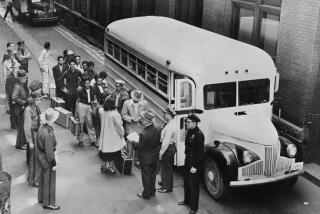Santa Fe tribute to Spanish conquistadors gets makeover to acknowledge suffering of tribes

Civic leaders in New Mexico’s capital city turned the page Friday on a grinding dispute over the annual reenactment of a 17th century conquistador reclaiming Santa Fe after a Native American revolt.
The decades-old pageant of Spanish soldiers in armor was replaced with new gestures of reconciliation at Santa Fe’s autumn festival, which started with Catholic Mass and a performance by Indian Pueblo dancers.
“Today marks a new beginning as we lay the past to rest through our mutual acknowledgement of the pain, agony and suffering that took place,” said Paul Torres, chairman of a council of tribal governors in New Mexico that helped negotiate an end to the reenactment.
A proclamation signed Friday by Hispanic and Native American civic leaders acknowledged “wounds older and deeper than any on this continent.”
“On behalf of those from the past who cannot ask forgiveness, we do so now,” the proclamation said.
Public statues and tributes to Spanish conquerors have encountered mounting criticism tied to the brutal treatment of American Indians centuries ago by Spanish soldiers and missionaries. Activists draw parallels to the national controversy over Confederate monuments.
Santa Fe’s “Entrada” reenactment depicted the reentry of conquistador Don Diego de Vargas into Santa Fe after the Pueblo Revolt of 1680.
Latino organizers for many years insisted that the reenactment was a celebration of Spanish settlers who defied the odds, settled hostile territory and came to an understanding with Native Americans unlike Europeans in other parts of the present-day United States.
Critics of the reenactment say it glorified colonialism and glossed over the continued violent subjugation the region’s Native American tribes endured.
Under the new plan, Santa Fe will host to a monthlong celebration that ends with Indigenous Peoples Day on Oct. 8 at Santa Fe’s central plaza.
More to Read
Sign up for Essential California
The most important California stories and recommendations in your inbox every morning.
You may occasionally receive promotional content from the Los Angeles Times.










